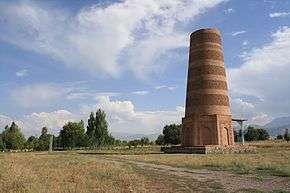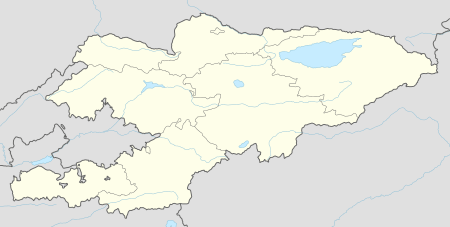Balasagun
 The Burana Tower, at the site of what was once Balasagun | |
 Shown within Kyrgyzstan | |
| Alternate name | Gobalik |
|---|---|
| Location | Chuy Province, Kyrgyzstan |
| Region | Sogdia |
| Coordinates | 42°44′49″N 75°14′55″E / 42.74694°N 75.24861°ECoordinates: 42°44′49″N 75°14′55″E / 42.74694°N 75.24861°E |
| Type | Settlement |
| History | |
| Founded | 9th century |
| Site notes | |
| Condition | In ruins |
Balasagun (Turkish: Balasagun -Balassagun, Balasaghun, Karabalsagun; Chinese: 八剌沙衮; pinyin: bālàshāgǔn, Persian: بلاساغون) was an ancient Soghdian city in modern-day Kyrgyzstan, located in the Chuy Valley between Bishkek and Issyk-Kul Lake.
Balasagun was founded by Soghdians, a people of Iranian origin and the Soghdian language was still in use in this town till the 11th century.[1]
It was the capital of the Kara-Khanid Khanate from the 10th Century until it was taken by the Kara-Khitan Khanate in the twelfth century. It was then captured by the Mongols in 1218. The Mongols called it Gobalik ("pretty city"). It should not be confused with the city of Karabalghasun in Mongolia which was the capital of the Uyghur Khaganate.
Founded by the Kara-Khanid Khanate in the 9th century, Balasagun soon supplanted Suyab as the main political and economical centre of the Chuy Valley; its prosperity declined after the Mongol conquest. The poet Yusuf Has Hajib, known for writing the Kutadgu Bilig, is thought to have been born in Balasagun in the 11th century. The city also had a sizable Nestorian Christian population; one graveyard was still in use in the 14th century.[2] Since the 14th century, Balasagun is a village with plenty of ruins, 12 km southeast of Tokmok.
The Burana zone, located at the edge of Tokmok and 6 km from the present village of Balasagun, was the west end of the ancient city. It includes the Burana Tower and a field of stone petroglyphs, the bal-bals. The Burana Tower is a minaret built in the 11th century on the ruins of the ancient city Balasagun. It is 24 m (79 ft) in height, though when it was first built it topped 46 m (138 ft). Several earthquakes through the centuries caused much damage, and the current building represents a major renovation carried out in the 1970s.
References
| Wikimedia Commons has media related to Balasagun. |
- ↑ Barthold, W. "Balāsāg̲h̲ūn or Balāsaḳūn." Encyclopaedia of Islam. Edited by: P. Bearman , Th. Bianquis , C.E. Bosworth , E. van Donzel and W.P. Heinrichs. Brill, 2008. Brill Online. UNIVERSITEITSBIBLIOTHEEK LEIDEN. 11 March 2008 <http://www.brillonline.nl/subscriber/entry?entry=islam_SIM-1131>
- ↑ Klein W. Das nestorianische Christentum an den Handelswegen durch Kyrgyzstan bis zum 14 Jh., Silk Road Studies III, Brepolis, 2000.